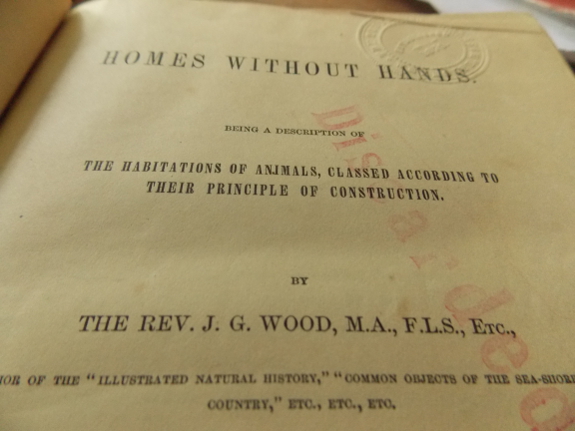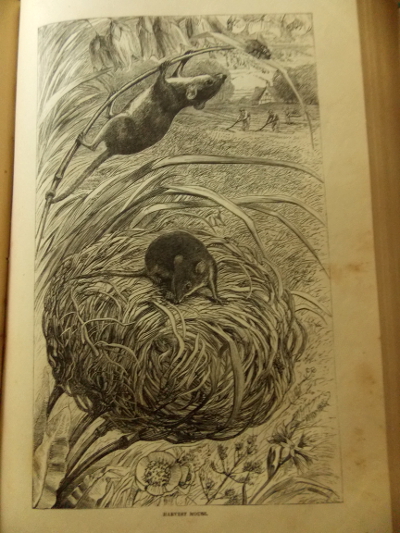
Pondering old books

Mom brought me this
140-year-old book yesterday, and I've been pondering it ever
since. Books like this always feel like an opportunity, but I
generally end up asking myself, "An opportunity for what?"
 The
illustrations are beautiful...but the text is really only interesting
to folks who are intrigued by both nature and history and thus don't
mind mentally translating captions like "hive bee" into "honey
bee." There is a print-on-demand version of the title available on
Amazon already, but the book's lack of ranking within the store means
it's probably never been purchased.
The
illustrations are beautiful...but the text is really only interesting
to folks who are intrigued by both nature and history and thus don't
mind mentally translating captions like "hive bee" into "honey
bee." There is a print-on-demand version of the title available on
Amazon already, but the book's lack of ranking within the store means
it's probably never been purchased.
My mind wanders through
various scenarios for bringing the heart of this book back into the
public eye. I could hire someone to scan every image and simply
write a quick summary of the nest to go with each picture. Or I
could think outside the box and turn it into a children's story since
the author's theme (animal nests) is very age-appropriate.
I've gone through similar
mental perambulations over more homesteading-related titles, and always
ended up veering away because I have a hard time figuring out which
books are really in the public domain and up for grabs. Robert Plamondon
does an excellent job bringing old farm-related titles back into print,
so perhaps I should leave the job to him. But it's hard to turn
down opportunities when they stare me in the face so prettily....
Ideas?
Want more in-depth information? Browse through our books.
Or explore more posts by date or by subject.
About us: Anna Hess and Mark Hamilton spent over a decade living self-sufficiently in the mountains of Virginia before moving north to start over from scratch in the foothills of Ohio. They've experimented with permaculture, no-till gardening, trailersteading, home-based microbusinesses and much more, writing about their adventures in both blogs and books.
Want to be notified when new comments are posted on this page? Click on the RSS button after you add a comment to subscribe to the comment feed, or simply check the box beside "email replies to me" while writing your comment.

Yes, written in the years leading up to the Civil War, and published in the decade after it: the writer had his idea, of Homes Without Hands, and maybe he chiefly was writing after he created the scenes that are so fanciful. This was also the period of whaling, and of South Sea Island discovery. (btw, when did Darwin have his Beagle voyage?) I think of that sketcher-writer, and remember Charles Kingsley's Water Babies (Kingsley was, first, a minister, and all the "lessons" he embellished his fanciful episodes with, I skimmed, when I read that book as a child. That is, I couldn't take to heart the moral reasoning behind Ton's becoming covered with thorns, I think, while at the same time in my life, I never skipped Jack London's "lessons", or Will James', in Smoky, or Lone Cowboy. I read those lessons avidly, as sort of "How to's", trying to learn!
I guess I might try to skim the text, to see if it is "purely" scientific, just to see the real purpose of this book.
I think the children's book approach is one of the happiest ones, in using this! I can see that maybe that book was to have been sort of an all-purpose "reference book" back in the days of wonderful personal libraries (which even had their own bookcase ladders). How to convey some of the fun of the illustrations? I can see the old grandparent holding a little toddler on her lap, pointing out all the amazing parts of the drawing, the strange perspective of the Eskimos dogs way off in the distance, as seen from inside the polar bear's ice cave, for ex. Drawings can be so fanciful!
Maybe save this book for ideas, or to give to a child who would be mesmerized, and forget the writing, except that the writing sort of does frame the pictures. Most of it conveys a feeling of safety, in spite of possible hunters, or prey.
If the author was this guy (Englishman, died 1889), any copyright will have expired by now. It doesn't matter if Engish or U.S. law applies.
See copyright lenghts;
The illustrations (engravings?) are well worth preserving in digital form, in my opinion.
This is an interesting post. Maybe most people argue with themselves over whether or not old books are worth the gladness they bring. Some things are just intrinsic. We like figs because they taste good. We appreciate touching those old pages and peering into odd expressions because it makes us feel good.
Enjoy that pleasure!
Thank you, Roland, for looking up this author-sketcher! I agree that the illustrations need to be disseminated (I wouldn't mind having a poster-size of some, either, or postcards...!) Good idea to skim the text, too, just to see if any thoughts are worth passing on. Actually, Anna, my sense of the safety conveyed was in the "quiet time shared" that the reader and art-lover has to take--since ideas, and themes--from a book--can be anytime, not dependent on electricity! Neat that he gave sketch-lectures, which might be the best way to teach. Maybe his notes (lectures) were in his preps for creating the etching.
Possibly, if Anna wanted, you could lend out a book like this, Certainly it would be neat to have this available on "inter-library loan" somehow? Another use might be for the teacher to read most of the "facts" about a particular creature, then to let the students draw their own conceptions of what the habitat actually was is. Maybe, if you have time, Anna, you can read how he actually got his facts, if he tells, in the foreword?
If it was published before 1923 it is in the public domain (that is, it doesn't have a copyright anymore). Some books published after that time are in the public domain, but figuring out if they are is a little trickier. And there are many ways of making money from public domain text and images. I've read a lot about how to find out what is in the public domain and not, how to make money from them, and I love this sort of thing...I am not an expert, but I think I know a lot about it. You had a lot of good ideas...I love the idea of creating a story based on them.
There are people who love to use these old images for crafts and decorating and other projects. I've seen people who collect these images scan them in and sell them in digital format on sites like Etsy (the great thing about doing this on Etsy is that they will automatically deliver digital products to customers, so you don't have to do a lot of work. I have been planning on doing stuff like this myself.
I've also seen people just give images like this away on blogs. Check out thegraphicsfairy.com to see how she gives images away (but makes money from advertising I suppose) and examples of craft and home decor projects people use them for.
One thing I have done is I actually use images that are in the public domain to put on Print On Demand (POD for short) products at sites such as Zazzle.com and CafePress.com. Sites like these show the images on products such as t-shirts and mugs and if a customer buys one they print it and send it to the customer and give me a commission.